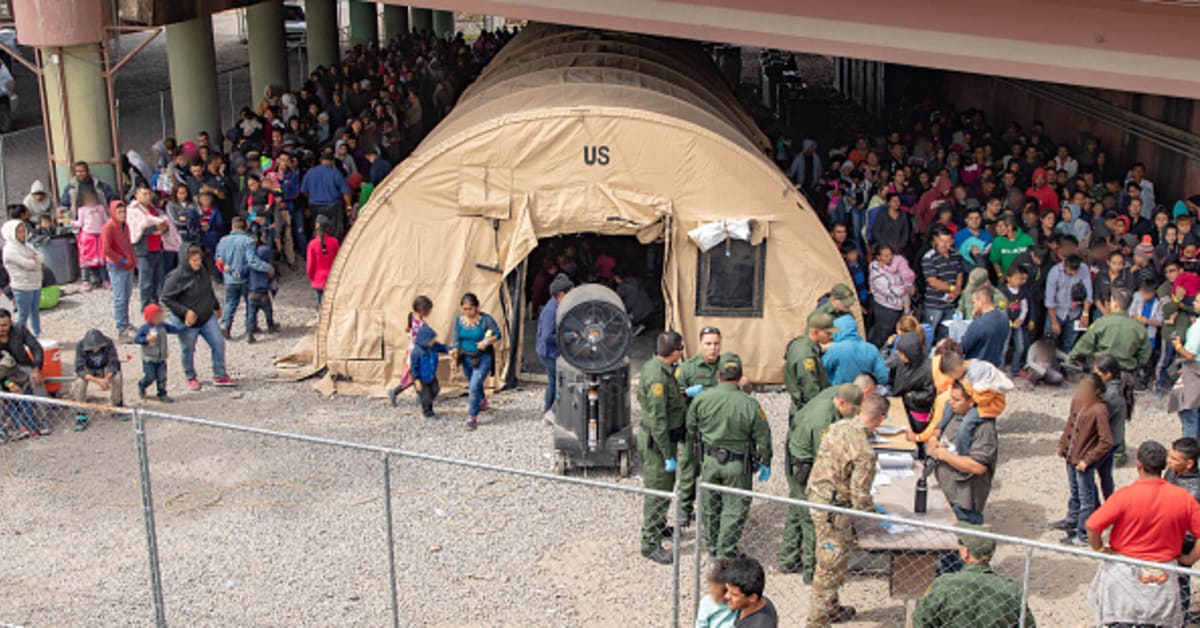The border agency, with no room elsewhere, has resorted to using an outdoor fenced space as a ‘transitional shelter’
by Edwin Delgado
Every day, thousands of people cross the Paso del Norte bridge between El Paso, Texas, and Ciudad Juárez, Mexico. For the past two days, the small shaded area underneath the bridge has also been busy: hundreds of recently apprehended migrants are now spending hours out in the open behind a chain-link fence and razor wire.
US Customs and Border Protection (CBP) says they are there due to the continued rise of mostly Central American migrants who have to be processed at various ports of entry and have generated a bottleneck.
“Due to the large volume of apprehensions within the El Paso station’s Area of Responsibility, the agency has undertaken additional measures to facilitate processing,” said CBP in a statement. “As [migrants] arrive at the processing facility, they are placed at the ‘tent’ to await their turn to be processed. This tent serves only as a transitional shelter and is not a temporary housing facility.”
The transitional shelter was put in place last month. This week, the fence and wire were installed amid a rise in the number of people being held.
On Wednesday afternoon, as the temperatures rose over 80F (26C), most of the migrants waiting to be processed sat along the edges of the shelter or lay down covered with foil sheets given to them by CBP.
Some of them looked away to avoid being photographed; others followed journalists who took photos and notes. Still others, exhausted from the long trek to the US, took a few minutes to rest and get a bit of sleep before the next leg of their journey.
A CBP spokesman, Ramiro Cordero, said he didn’t have an accurate estimate of the number of migrants at the shelter because it fluctuated every hour. But he said that as of 6am on Wednesday, CBP’s El Paso sector, which covers New Mexico and parts of west Texas, had approximately 3,500 migrants in custody. The sector is averaging 570 daily apprehensions this month, up from around 200 a day early last year. He noted the migrants in the shelter had been detained within the last 15 to 20 hours.
“We keep getting better and better at processing them,” Cordero said. “However, the numbers continue growing and growing. We don’t have anywhere else to hold them.”
Another CBP official, who asked not to be named, told the Guardian that if the current situation did not improve, CBP might have to release some of the migrants it processes into the streets rather than waiting for other agencies to pick them up.
CBP, which makes the apprehensions at the border, must wait for Immigration and Customs Enforcement (Ice) to process migrants before releasing them to them. Ice also, at times, works with local non-government agencies to coordinate the release of some of the migrants into the community.
Only two blocks away from the bridge, the CBP commissioner, Kevin McAleenan, said at a news conference on Wednesday morning that the number of migrants coming to the US was unprecedented. He said on that morning CBP had more than 13,000 migrants in its custody; normally, it was closer to 4,000.
“This stark and increasing shift to more vulnerable populations, combined with the overwhelming numbers, and inadequate capacity to detain families and children at Ice and HHS, respectively, has created a humanitarian crisis,” McAleenan said. “In March, almost 40,000 children will come into CBP custody after completing a harrowing journey in the hands of violent and callous smugglers through Mexico. The danger of violent assault on that journey, the potential for a tragic incident in the crossing or in overwhelmed CBP facilities, or in transportation networks, is clear and present.”
He noted that 40 percent of CBP officers were focused on handling the influx of migrants.
As buses began to arrive at the shelter to take migrants who had been processed, others anxiously waited for their chance to, at the very least, be moved inside the CBP facility. (The Guardian).



